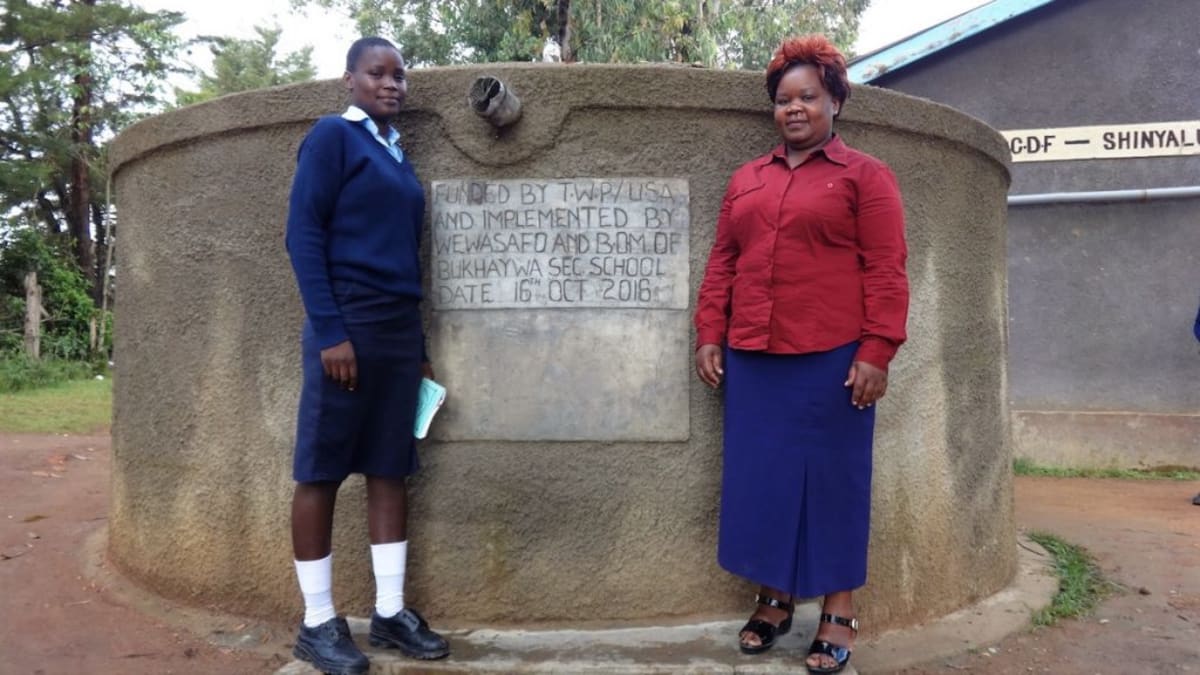This project is a part of our shared program with Western Water And Sanitation Forum (WEWASAFO). Our team is pleased to directly share the below report (edited for clarity, as needed).
Welcome to the School
Bukhwaya Secondary School is located in Bukhaywa Village, Buyangu, Kambiri, Ileho, Kakamega East of Kakamega County, Kenya. The school was started by the Friends Church in 1989. It now has a total student population of 469, of which 256 are boys and 213 are girls. The school employs 25 teachers and 11 support staff. (Editor’s Note: While this many people may have access on any given day, realistically a single water source can only support a population of 350-500 people. This school would be a good candidate for a second project in the future so adequate water is available. To learn more, click here.)
A normal day at the school begins at six in the morning. Students come from all over, as far as six kilometers away. The students who come from neighboring villages have bicycles, which can be seen lined up in a picture under the "See Photos & Video" tab. These were donated by an organization that has a heart to help these students, too!
Form one and two are responsible for cleaning the school compound for 7AM to 7:25AM. After cleaning, all students gather together to parade and raise the flag. The teacher on duty addresses the students and makes announcements. Lessons then begin at 8AM and stretch until 4:30PM.
During classes, most parents are busy tending to livestock. Others specialize in buying and selling these animals in the nearby Lubao Market. Dogs, cows, goats, sheep, and pigs are in and out of the community on a daily basis.
Water Situation
The main water source is a hand-dug well that goes dry during part of the year. This well doesn't have a pump, so fetching its water must be done manually with a rope and bucket. When there's no water in this well, students must walk one kilometer away to an unprotected spring (we plan to protect this spring in 2017). A lot of time is wasted, whether fetching water with the bucket or walking long distances back and forth.
There are four small plastic water tanks on school grounds. Two of these have a capacity of 5,000 liters, and the others are 1,000 liters. Once it stops raining, the water in these tanks is used up within a week.
Sanitation Situation
The school has 18 useable pit latrines. Four of these are set aside for teachers, leaving 14 for students. Many of these latrines left for students have broken doors, leaving students with no privacy. Due to inadequate water in the school, latrines are very dirty and expose students to infections and other complications. Students also waste a lot of time during breaks waiting their turn for the latrine.
The situation is dire, however, because the Ministry of Roads has ordered all student latrines to be demolished for impending construction.
Classrooms are dirty, so students worry about jiggers. There is only one hand-washing station that is set aside for teachers. The students admit there's no way to wash their hands after using the latrine or before eating. Plus, the little amount of water available is used up for drinking and cooking. No water is every left for washing or cleaning.
The school has taken initiative to improve their environment, but they can only do so much without water. They have dug a compost pit, but litter has not been separated properly. They are in serious need of training and a new water supply.
Plans: Hygiene and Sanitation Training and Hand-Washing Stations
Training will be held for two days. The facilitator will use PHAST (participatory hygiene and sanitation transformation), ABCD (asset-based community development), CTC (child to child), lectures, group discussions, and handouts to teach health topics and ways to promote good practices within the school. The CTC method will prepare students to lead other students into healthy habits, as well as kickstart a CTC club for the school. This CTC club will oversee the new facilities, such as hand-washing stations, and make sure they are kept clean and in working condition. The two hand-washing stations will be delivered to the school, and the club will fill them with water on a daily basis and make sure there is always a cleaning agent such as soap or ash.
Plans: Rainwater Catchment Tank
A 30,000-liter rainwater catchment tank will be constructed on school grounds. Teachers, students, and parents will gather the materials needed for this project, including sand, ballast, bricks, and hardcore. This contribution will fuel a sense of responsibility for the school and community to take care of their new facilities. Once materials are mobilized, the WEWASAFO team will arrive to lead the construction effort.
With adequate clean water, the school will have water for drinking, cooking, cleaning, hand-washing, and irrigation! The school's food program wants to maintain a garden that will help provide food for hungry students.
Plans: VIP Latrines
These six new latrines are coming at the best time for this school. While the old latrines are being torn down for the new road, the VIP (ventilated improved pit) latrines will be built as their replacements. There will be three doors for each gender. Latrine materials will be mobilized the same way as the tank, ensuring the school feels these facilities are truly theirs.
School administration and parents are positive that with these new facilities and training, their students’ academic performance will improve. Students will be healthy and empowered to focus on what's important!
Thank You for unlocking potential at Bukhaywa Secondary School!

 Rainwater Catchment
Rainwater Catchment
 Rehabilitation Project
Rehabilitation Project























